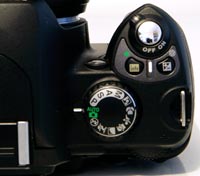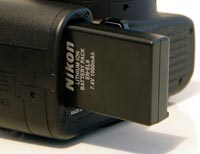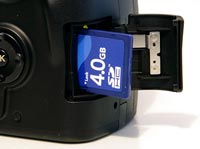Nikon D40 Review
Review Date: January 15th 2007
Leave a comment about this Review
|
Introduction

The Nikon D40 surprised everyone when it was announced at the end of 2006. A DSLR camera with an 18-55mm lens for less than �450/ $680 from one of the big two manufacturers, the Nikon D40 makes the DSLR format affordable to more people than ever before. Following on from the popular D50 model, the Nikon D40 is a cheaper but no less capable DSLR. Nikon have largely kept the cost down by resisting the urge to increase the megapixel count and continuing to use a 6 megapixel sensor. The main "sacrifice" is the removal of the internal focus drive motor from the D40, which means that it is only compatible with newer AF-S/AF-I (which have built-in motors). Older lenses can only be used in manual focus mode. Nikon have also removed the top-panel LCD, more because the D40 is quite small than as a cost-cutting exercise. This is all of little consequence to the Nikon D40's main target market, however, which is first-time DSLR owners and compact digicam users trading up to a more "serious" camera. Nikon have pulled out all of the stops to make the D40 as easy to use as possible. The D40 is small, light, has relatively few external controls for a DSLR, offers a range of scene modes, a built-in help system, Retouch menu for in-camera enhancements, and an innovative Info screen which gives quick access to the main controls. All of this sounds great, but is the D40 still a capable DSLR? Carry on reading to find out what we thought of the new Nikon D40.
Compare Prices
Support PhotographyBLOG: Buy the Nikon D40 from one of our affiliate retailers:Ease of Use
When you first take the Nikon D40 out of its box, you can literally feel why this digital SLR is so cheap. Its all-plastic construction makes it very light, especially if you have used a more expensive DSLR. The same is true of the supplied 18-55mm kit lens, which again is made entirely of plastic. At this point you may be wondering if you made the right purchasing decision, but fit the body and lens together and it all begins to make much more sense. Suddenly you have a well-balanced package that is light by DSLR standards, but which doesn't feel flimsy or inconsequential. Nikon have also resisted the urge to make the D40 as small as some of its main rivals, notably the Canon EOS Rebel XTi / 400D and the Olympus E-400. Instead the D40 continues in the same vein as the older D50, with a chunky handgrip and a "business-like" design that is functional rather than pretty. The D40 is definitely designed for "normal" hands, and this helps to negate that initial feeling of the camera being too light and plasticky.
Despite being aimed at the new digital SLR owner, the D40 is still a fairly complex camera in terms of functionality and the number of external controls that it offers, with around 16 in total and some of them having more than one function. Despite the presence of so many buttons and switches, the Nikon D40 doesn't feel too cluttered or intimidating and quickly becomes second-nature to use. The D40 is very comfortable in terms of handling. The camera has a deep, contoured handgrip on the right-hand side, coated in a rubberized compound to aid grip, that enabled me to use three fingers to hold it and my right forefinger to operate the shutter button. There is a small contoured area where your right thumb sits, with the rest of the body finished in shiny smooth black plastic. The standard 18-55mm kit lens feels well-balanced on the Nikon D40 and it fits into place with a reassuring mechanical click. The shutter release action on the Nikon D40 is quite loud and mechanical, something that you will either love or hate. I liked it, although it isn't great for close-up candid photography as your subject will probably hear you if you get too close.
The Nikon D40 is generally well-made and designed. The Nikon D40 follows conventional DSLR design in having a shooting mode dial on the top of the camera, which allows you to select either one of the advanced mode like Aperture-priority, or 7 scene modes. The Exposure Compensation and Info buttons, which are located next to the shutter button, are thoughtfully positioned. Hold down the Exposure Compensation button with your right forefinger and spin the dial on the top-rear of the camera with your thumb to adjust its settings - simple and intuitive.
The Info button is a very interesting addition which is at the heart of the D40's ease-of-use. Nikon have removed the top LCD panel in order to make the D40 smaller than its previous DSLRs. Consequently, they had to find a way to display the very useful information that was previously shown on this screen. Enter the Info button - pressing it displays virtually all of the camera's main settings on the large rear LCD screen. Existing DSLR owners may think that the removal of the top LCD panel is a backwards step, but I think the D40's target audience will love it. Compact digital camera owners use the rear LCD screen all of the time, so it make perfect sense to utilise it on the D40. Even more impressively, Nikon haven't stopped there. If you press the Info button and then the Question Mark button on the rear of the camera, you can actually move around and change 10 of the most important camera settings, including ISO speed, white balance, file quality and flash mode. There's even a graphical representation of each setting which clearly shows the results of the changes that you make. You could never do any of that on a top-panel LCD!
| Top Controls | Rear Controls |
 |
 |
Nikon have simplified the way that the Shutter-speed, Aperture and Manual modes are implemented on the D40. Instead of having two dials as on the D80, one just below the shutter button on the top of the handgrip which changes the shutter speed, and the Main Command dial on the rear of the camera which changes the aperture, the Nikon D40 only has the Main Command Dial on the rear. This means that it is more difficult to alter the aperture and shutter speeds when the camera is set to Manual mode, as you have to hold down the Exposure Compensation button and turn the dial at the same time to change the aperture. Most D40 users may never notice this, as they may never use the Manual mode, but more experienced photographers should take note. Other notable omissions include the lack of a Depth of Field Preview, any bracketing functions, and dedicated buttons for ISO speed and some other commonly used options (although you can customise the Function button to access one of these). Compared to the older D50, Nikon have added a mirror lock-up function, customizable Auto ISO, an ISO 3200 setting, slightly more powerful built-in flash, and SDHC support.
Considering that this is a complicated digital SLR camera with an array of advanced features, the Nikon D40 has a clean and uncluttered design that will be familiar to anyone who has used a DSLR before, although it will be initially intimidating for someone who hasn't used one. Users of bridge-style compacts will be most at home - the D40 is actually quite similar to the Fujifilm Finepix S6500fd which I was testing at the same time. I strongly recommend that all users read through the excellent user guide first, which contrary to recent trends is actually printed rather than supplied on a CD.
The menu system of the D40 is very clear and easy to use. There are 4 main menu options, Playback, Shooting, Custom Setting Menu, Setup and Retouch, represented by both icons and text. The various options in each of the 4 menus are clearly displayed in a large font size, and cleverly the current setting for each one is shown to the right as an icon - very neat. The most complex menu is the CSM one, with 17 different options available, although many of them will only need to be set once (and you can also change the menu to "Simple" mode so that only 6 options are shown). Overall I found the menu system easy to read, understand and use - full marks to Nikon.
| Battery Compartment | Memory Card Slot |
 |
 |
One prominent feature in the Nikon D40 menu is a new Retouch menu section enabling you to perform in-camera image editing, effects and enhancements. These include automatic red-eye correction and cropping facility, as well as a D-lighting image optimising function and monochrome and filter effect settings. While many users might prefer to have more control by editing images via a PC, these are useful nonetheless, delivering reasonable results in a few seconds.
The start-up time of the Nikon D40, from turning the camera on to being ready to take a photo, is very quick at around 1/4 second. The Nikon D40 "only" has a 3-area autofocus system, but I found that focusing is quick and consistent in good light with the standard kit lens, and the camera happily achieves focus indoors and in low-light situations thanks to the powerful AF Assist light. The 18-55mm kit lens is quiet in operation and feels well balanced on the D40 body. The large, high-resolution 2.5 inch LCD screen is bright, clear and has a perfectly acceptable refresh rate. It takes about 1 second to store a JPEG image at the highest quality setting with no discernible lockup between taking shots, allowing you to keep shooting as they are being recorded onto the memory card. For RAW images the Nikon D40 takes about 3 seconds to store an image and there is also no lockup between shots until the buffer is full after 9 shots - at this point the shooting rate slows down until the buffer is cleared. In the best quality JPEG mode, the D40's continuous mode allows you to take 2.5 frames per second for an unlimited number of shots.
Once you have captured a photo, the Nikon D40 has an excellent range of options for playing, reviewing and managing your images. You can instantly scroll through the images that you have taken, view thumbnails (in 2 different sizes), zoom in and out, and view detailed information about each image by pressing up or down on the Multi-selector. You can also delete an image, automatically rotate an image, view a slideshow, set the playback folder, and set various printing options. Importantly the Nikon D40 displays a histogram for a photo, which is a great help in evaluating the exposure, plus any areas that are over-exposed flash on and off in the LCD preview to show you what you should be compensating for with your next attempt.
In summary the Nikon D40 is an all-plastic yet well constructed DSLR that is intuitive to use. As with the more expensive Nikon D80, the D40 inspires confidence in its target audience and allows you to get on with taking pictures.
|
![]() PhotographyBLOG
is a member of the DIWA
organisation. Our test results for the Nikon D40 have been
submitted to DIWA
for comparison with test results for different samples of
the same camera model supplied by other DIWA
member sites.
PhotographyBLOG
is a member of the DIWA
organisation. Our test results for the Nikon D40 have been
submitted to DIWA
for comparison with test results for different samples of
the same camera model supplied by other DIWA
member sites.
